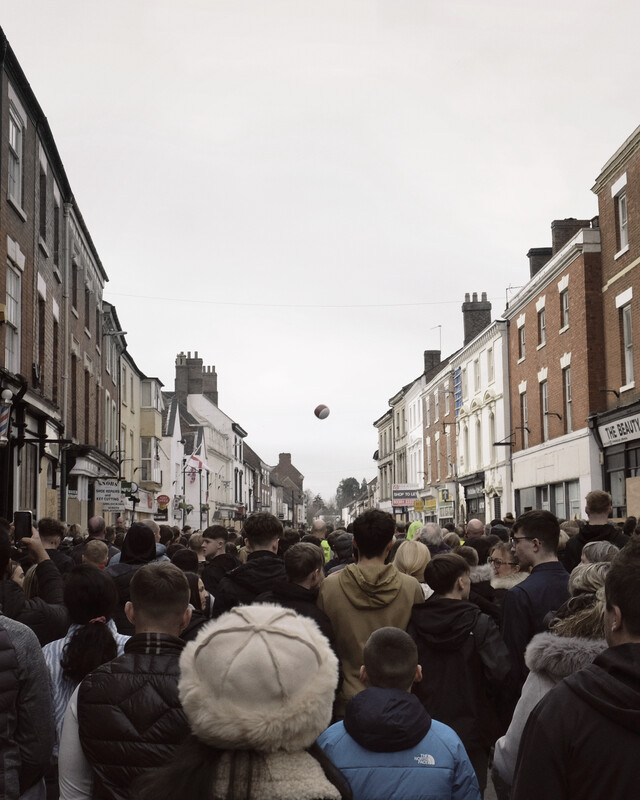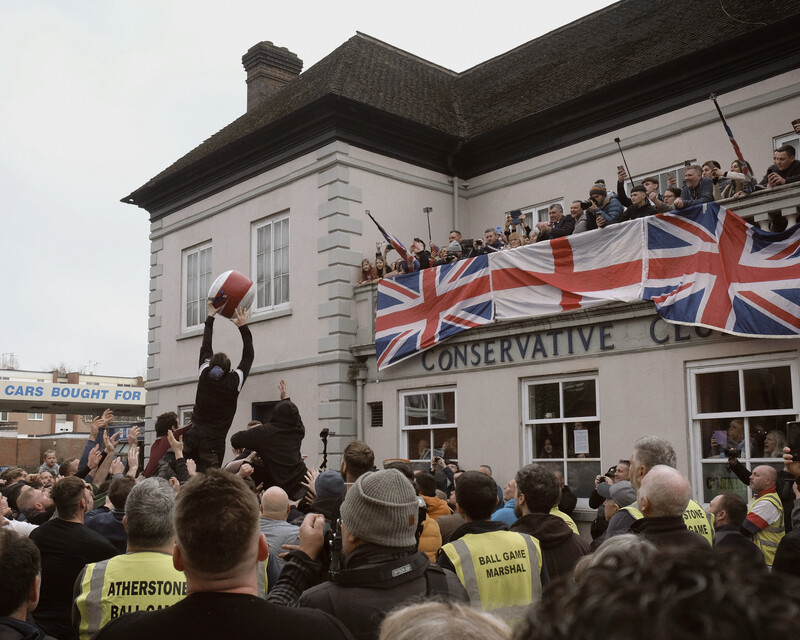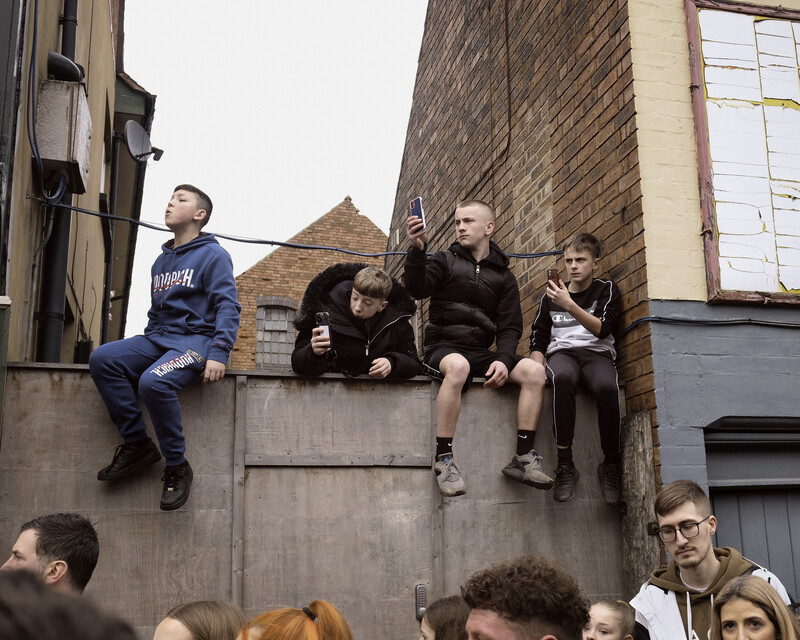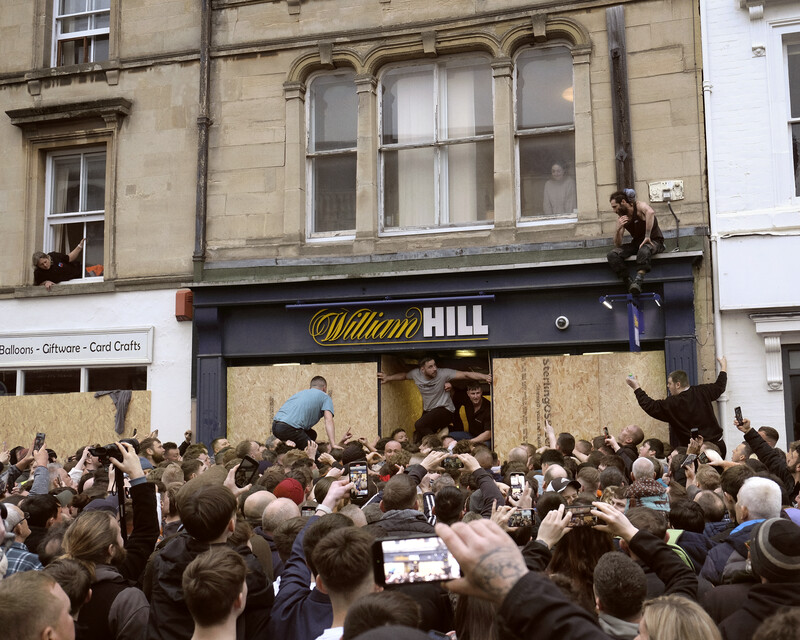Atherstone Ball Game
© Daniel MooreyWarwickshire, England
A game with two rules. Stay on the high street. Don’t kill anyone.
It’s played once a year on Shrove Tuesday, a traditional day for merriment since medieval times but also for the licensed misrule which sums up the Atherstone Ball Game. That misrule has made the event notorious for its visceral violence but in real life, as opposed to Twitter/X, it’s a bit more nuanced.
Not many sports events have been going for 823 years, not many sports we play now were even invented back then. In truth, there seems to be a little debate about the first playing of the Atherstone Ball Game although whoever Ralph of Witherley was, in 1790 he wrote that it had been around since the reign of King John which was 1199-1216, lest you forget. It has only knowingly been cancelled for……..yep covid, the scourge of many a historian of annual events. The first game was between Warwickshire and Leicestershire, a bag of gold was both the ‘ball’ and the prize. Warwickshire won and Atherstone decided the game was worth another 824 goes, albeit with some changes along the way.
There are some similarities with other ball games across the country, common themes being: scoring in your own goal, not in the opposing one, a fluid relationship between spectating and competing, taking place at festival time, a lack of rules and a little bit of violence. Sometimes called mass football or festival football, aficionados could also check out: East Anglian Camp Ball, Welsh Cnapan, Cornish Hurling and Kirkball Ba’a. Some form of rugbyesque scrum is common, a hug at Ashbourne, a sway at Haxey or a hot at Winchester, at Atherstone it’s called……a scrum. The lack of a pitch is another common thread and arguably the most exciting feature. The action taking place in front of a boarded up Superdrug is in sharp contrast to the everyday high street, especially if you were in there the day before buying toothpaste, although if you’ve been playing the game, bandages would be more appropriate.


What’s the game then? The day starts with sweets thrown from the balcony of the Connie (Conservative Club). Gradually the kids are replaced in the crowd by some big units that look like they might be UFC contestants and the ball is thrown to the baying throng at 3pm by a local celebrity. It’s a cheese shaped number, 27 inches in diameter, 4 pounds in weight, handmade in the town and painted with a different theme each year; King Charles in 2023. There are no goals and no formal teams. The ball is punted up and down the street for around 90 minutes of testing out everyone’s mettle but around 4.30pm it all gets a bit more serious. When the 5pm klaxon sounds, the person holding the ball is the winner, so it’s usually moved towards a doorway that can be defended by a small group who are then attacked by people from the next village or the wrong pub. There are tactics here and Danny Riley (with the swollen eye in one of the images) was seemingly taken out early as the Lionel Messi of nearby Grendon village, although he carried on playing and smiling. This last section of play is where the Twitter feeds get their violent viral content. You don’t risk getting the shit kicked out of you for the prize money but the winner does get to keep the ball and the glory every time they go to buy that toothpaste
The Mirror describes every year as ‘descending into violent chaos’ with ‘mass brawls’ and ‘unrestrained violence’. The Independent says 2023 ‘descended into chaos as violence broke out’. Everyone needs a headline although even historian Hugh Hornby in his book Uppies and Downies, describes the final stages as ‘a brutal trial of strength, almost primaeval in its intensity. Lawn bowls this is not. Even the original 1199 game was said to have ‘descended into violent chaos’ although how anyone knows is unconfirmed. The violence is shocking at first but it’s also between consenting adults and a family atmosphere still prevails among the roaring crowd. The whole town seems dedicated to the game, everyone has memories of it and some of winning it. The woman who on the left in one of the below images has been to every game since she was 11. The atmosphere is less volatile than a Saturday night on Norwich’s Prince of Wales road but possibly more blood is spilt.
There might be only two rules but there is societal consent and an agreed set of verbal conventions even if they aren’t written down. It’s a local crowd which makes it self-policing, no one wants to be a social pariah, trouble might come when outsiders manage to take part. This is how English Heritage describes these ancient ball sports; ‘Each game stands alone; its own, self-contained local derby, played with no heed to the outside world.’ That said this is how a Frenchman described them in 1831; ‘If Englishmen call this playing, it would be impossible to say what they call fighting’.




Atherstone, despite its tough rep, is heavily and very well stewarded. 2023 saw Cindi become the first female steward. There were no women taking part though, despite women joining the scrum at Haxey in Lincolnshire, playing at Hallaton in Leicestershire and scoring goals at Ashbourne. Inveresk’s version near Edinburgh was contested by married against unmarried women. In the first 90 minutes of play, kids are given the chance to kick the ball, including girls, so there is potential new talent for the future which could cause the game to adapt again or not.
Adaptation has been a recurring feature which has enabled the game’s longevity. In the 19th century puritanism was a constant threat, along with the cost of damage to buildings, insurance brokers, the risk averse health and safety crowd, and anyone from Warwickshire County Council. Some traditional ball games have adopted very loose structures to avoid litigation and Atherstone’s game is now played only on the main street in order to limit damage. Many ‘folk’ rituals have lost their vitality and excitement but not this one.
It's a great spectator sport, described by our friend Hugh as a ‘double bill of friendly, ritualistic play for everyone, followed by feverish competition for the few’. It incorporates exercise, local tourism and enough social glue to make a community feel unique. It also has other perks, the Daily Mail quotes Jill, 61, from the pub; ‘People love it. The men go mad. The shirts all get ripped off. It is great for us ladies to see some nice fit lads.’
links
-
the full set of images in the archive
- The official site
-
The best survey of games like this is written by Hugh Hornby, edited by Simon Inglis and published by English Heritage
-
Excitingly, the Wealden village of Chiddingstone in Kent has started its own tradition within the last ten years
- Yes yes, I know you just want to see the moment a player’s eye was gouged and the betting shop got damaged
- The Coracle


